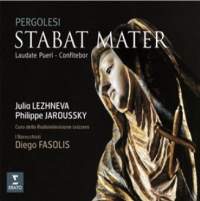Texte paru dans: / Appeared in:

Fanfare Magazine: 37:5 (05-06/2014)
Pour
s'abonner / Subscription information
Les abonnés à Fanfare Magazine ont accès aux archives du
magazine sur internet.
Subscribers to Fanfare Magazine have access to the archives of the magazine
on the net.
Erato
3191472

Code-barres / Barcode : 5099931914727 (ID380)
The Stabat Mater by Giovanni Pergolesi has been one of most beloved and iconic works of the 18th century. Given the composer’s almost deified status as a precocious genius who died way too early at the age of 26, the work attained an international reputation for purity and emotional expression in music. Of course, not everyone thought the same, for the famed Padre Martini thought it too secularized and reminiscent of the writing in his comic operas, but there were others who believed that it represented the best of musical purity in terms of expression and writing. This crew included Charles Burney and Jean-Jacques Rousseau. Indeed, it became an Easter staple in as far away as Stockholm (where it was re-orchestrated by Francesco Uttini about 1765).
It is far too short to fill out an entire disc, and conductor Diego Fasolis has chosen to augment it with two further authentic pieces, a nice pair of Vesper Psalms: the Laudate pueri, a festive work for two treble soloists, chorus, and a rather full orchestra including high trumpets, and the Confitebor tibi Domine for a similar setting but without the brass. Both of these were part of a setting of Marian Vespers composed sometime around 1732 or perhaps earlier. This is a felicitous pairing and orients the disc towards the few surviving works that Pergolesi actually wrote. Indeed, Fasolis waxes enthusiastic about the “opportunity” to record the Stabat mater to such an extent that he apparently is already planning a sequel to include the Pergolesi Mass and Dixit Dominus, both of which are even grander in terms of setting.
From the mysterious suspensions above a steady walking bass of the opening “Stabat mater dolorosa,” to the mysterious “Quando corpus” with its flowing accompaniment, to the strict, almost Dominican in tone fugal “Amen,” the work well deserves its reputation as iconic for the century. Due to this, no doubt, it has been repeatedly recorded, as have the two Psalm settings, as Pergolesi—the real Pergolesi—has experienced something of a revival in the last decade. Here, the booklet notes claim that the difference is the pairing of a countertenor with a rich and sonorous voice, Philippe Jaroussky, with a soprano who is at the initial stages of her career with a voice that is still malleable, Julia Lezhneva. Fasolis intends that this duo will enhance the “angelic” quality of the Stabat Mater. One may be skeptical of this reasoning, but there is no doubt that the two voices blend exceptionally well. Jaroussky has both fans and detractors for his interpretations, but I find that he is particularly suited to the sonorities of the famed work. His colleague has a smooth and lyrical tone, and the two of them together function like a harmonious stream, now contrasting in timbre, now blending easily so that their parallel lines are clear and expressive.
Not to make too fine a point on the Vesper Psalms, I find that both are a huge stylistic advance over the Stabat Mater. In fact, the Laudate pueri is downright raucous, which makes the piece powerful and joyous. The use of high trumpets and oboes also helps to enliven the feel of the chorus, and I have to admit that I am particularly fond of the final fugue. This is the way I think counterpoint functions best, with a steady motion bass and entrances of a nicely lyrical nature, and furthermore an integration of the various lines weaving sinuously throughout. In the “Quis sicut” the use of horns also gives a nice contrast to the voice and the outer choral movements, though these instruments are not mentioned in the cast list. The Confetebor, however, is another creature altogether, with a neat use of the chant cantus firmus against which Pergolesi arrays both the strings and chorus darting all about with almost a flurry of activity. The “Redemptionem misit” is a solemn procession of chromatic choral harmony, but in the “Confessio et magnificentia” their sudden appearance following a highly virtuoso opening section is somewhat disconcerting, introducing solemnity into a rather jaunty operatic prelude. It too disappears rapidly as the opening returns with joyous abandon. The hesitant chords of the “Santum et terribile” lead one to expect a majestic proclamation, but soon the text launches into some impressive coloratura. In the final “Sicut erat,” Pergolesi has even more fun. He opens with a quotation from the first chorus (for which the text “As it was in the beginning,” seems a nice pun), but just as one expects the final homophonic “Amen” chords, he inserts a coda with such statements interrupting some dizzying display by the two soloists.
As noted, both soloists are a nice complement to each other, performing the rather tortuous lines with ease and dexterity. Their intonation is not only correct in terms of each other, they are in tune with the orchestra as well. The sound of the recording is nicely bright, so that each and every small nuance is clearly delineated. I like Fasolis’s tempos, which are not break-neck or lugubrious, but rather flexible and keep things moving along. In short, this is a fine disc and a worthy addition to the collection. I, for one, cannot wait to hear their sequel disc, if it is up to the same quality.
Cliquez l'un ou l'autre
bouton pour découvrir bien d'autres critiques de CD
Click either button for many other reviews


